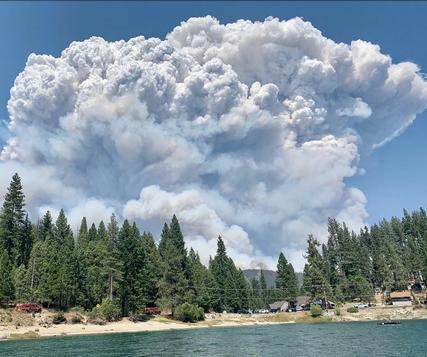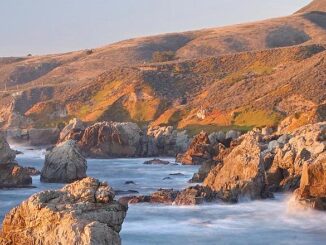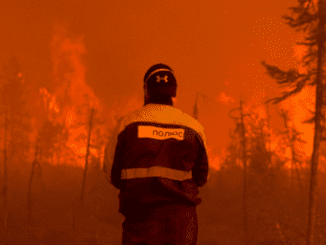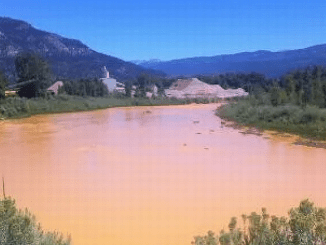
EUGENE, Oregon, September 8, 2020 (ENS) – Smoke filled the air in this university city on Tuesday, turning the sky orange and the sun red, as it did across much of the U.S. West. Thousands of firefighters are battling raging wildfires driven by extreme heat and hot, gusty winds that are threatening forests and residential areas across the region.
The weather is a mixed bag that is making the firefighters’ fight much more difficult. The National Weather Service warns that the strong winds on the western side of an unprecedented late summer storm that has brought snow to Yellowstone National Park, have also brought “dangerous and life-threatening fire weather conditions” to large parts of the western United States from the desert Southwest, through the Great Basin, much of California and into the Pacific Northwest.
An elevated to critical fire weather threat will continue across much of these areas through Wednesday, says the NWS, while diminishing winds are possible across the region by Thursday, bringing some relief from the ongoing fires and fire weather threat.

California forests are suffering a record-breaking year for the sheer area of burned acreage they have sustained – more than 2.2 million acres this year according to the National Interagency Fire Center.
At least 23 large fires now are burning in California, where dry, windy conditions and record-breaking high temperatures have been fueling flames for weeks in some areas.
California Governor Gavin Newsom is pointing to climate change as the source of the extreme heatwave and a primary factor in the scores of wildfires plaguing California.
The biggest fire in the country is the lightning-sparked August Complex fire on the Mendocino National Forest near Willows, California, which has burned 356,312 acres and is 24 percent contained. The Hull, Doe, Tatham, and Glade fires have merged to form this one large fire. There are 1,162 resources committed to the Complex. There is potential for increased fire activity and spread with heavy smoke production.
Evacuation orders are in effect for Glenn County, as well as portions of Mendocino and Lake Counties due to the August Complex.
Strong winds in northern California led the Bear Fire to spread explosively Tuesday and early Wednesday, forcing expanded evacuation orders. Mandatory evacuation orders of 20,000 residents were issued by Plumas, Butte, and Yuba county sheriffs’ offices.
“Today was a critical fire day with extreme fire behavior,” the U.S. Forest Service wrote in a Tuesday night incident update. A USFS order prohibits the use of any ignition such as campfires and gas stoves and the closure of all developed campgrounds and day-use sites on national forests in California.
The U.S. Forest Service has temporarily closed all southern California forests, including the Sierra National Forest, where the Creek Fire has consumed over 144,000 acres and forced the helicopter evacuations of hundreds of people who were on vacation in the campgrounds and on the trails.

Sierra National Forest, located on the western slope of the Sierra Nevada mountain range in Central California, is bounded on the northwest by Yosemite National Park and the south by Kings Canyon National Park.
U.S. Navy and California Army National Guard helicopters airlifted more than 207 people to safety on September 6, as the Creek Fire blazed out of control, blocking the only exit from a camping area at Mammoth Pool Reservoir in Sierra National Forest.
The Fresno County Sheriff’s spokesman Tony Botti said Monday night that some 200 people might still be in the High Sierra. He said they were safe and with deputies, but because smoke has been making it tough for the helicopters to land, they are waiting for safer conditions.
Five flights took place Tuesday, according to Major Jason Sweeney, a spokesman for the California National Guard. More are planned.
Col. David Hall with the California Army National Guard told CNN’s Wolf Blitzer Tuesday that 385 people and 27 animals have been rescued. Helicopter crews Tuesday airlifted at least 148 people who had been trapped by the Creek Fire.
Crews and equipment operators are working long shifts in extreme heat to construct containment line and implement structure protection measures.
Officials told families of those still stuck behind the fire lines that most were able to move to areas that are out of immediate danger until a safe evacuation could take place.
Meanwhile, the Creek Fire continues to grow under extreme conditions. The fire has had strong winds with upper-level winds from the northwest and variable lower level winds. The fire continued to grow in all directions with large increases to the south and east. The progression has threatened new communities in the foothills, especially with the winds predicted for today. Extreme fire behavior is still being observed with critical fuels and weather.
“Strong, dry winds from northeast in and around the mountains of the San Francisco Bay area, and also a rare early-season Santa Ana wind event in Southern California can lead to explosive growth of existing fires and any ones that develop,” AccuWeather Senior Meteorologist Dave Houk said. “The whipping winds, which can be erratic and enhanced by the fires themselves, will exacerbate the highly dangerous fire-fighting conditions.”
Pacific Gas & Electric Corp., the nation’s largest utility, is turning off power to keep winds from damaging its equipment. Power went out Tuesday, affecting 1.5 million people across Northern California.
Oregon
Further north in Oregon, thousands of Oregonians were forced to evacuate Tuesday, as wildfires state officials called unprecedented in modern memory blazed out of control.
With gusty westerly winds pushing wildfires over the crest of the Cascade mountain range, sparking even more fires, state fire officials, stretched to the limit, said that suppressing some of the fires that have already eaten hundreds of thousands of acres would have to wait.

Doug Grafe, chief of fire protection at the Oregon Department of Forestry, said conditions would likely mean officials would be unable to “really go on the offensive” to begin suppressing the fires until Thursday.
The invocation of the Conflagration Act by Governor Kate Brown on the weekend has cleared the way for the Oregon State Fire Marshal to mobilize firefighters and equipment to assist local firefighters battling three major wildfires and dozens of smaller blazes in western Oregon. One of these isthreatening the outskirts of Eugene.
Briefing reporters, Grafe explained that wind was just one factor that has caused dozens of blazes to spring up in Oregon and the Pacific Northwest. The high winds and some of the driest conditions in decades combined with an especially early cold front has made an ideal situation for fires to grow.
“You combine that series of conditions and you have a supreme alignment for destructive fires,” Grafe said. “That’s exactly what we’ve seen.
“We do not have context for this amount of fire on the landscape,” he said.
The winds have caused dozens of power outages. Due to extreme fire danger and NWS forecasts for high winds thru Tuesday, the Eugene Electric & Water Board estimates 3,000-4,000 customers will have to remain without power through the night. The utility has shut down substations near where fires are blazing, due to the high fire risk, leaving hundreds in the dar.
Numerous trees across Eugene fell and some are still hanging on, but are close to falling. Public Works crews and local contractors worked overnight and Tuesday to clear trees and other roadblocks.
Washington
Governor Jay Inslee of Washington said Monday that an estimated 330,000 acres had burned across the state, an acreage that is more than what burned in each of the last 12 fire seasons.
On August 19, Inslee issued a statewide emergency proclamation to ensure immediate response to multiple wildfires in Central and Eastern Washington, as well as on the Olympic Peninsula.
One of the biggest is the Cold Springs Fire that has burned more than 163,000 acres on the Colville Indian Reservation, one of five uncontrolled fires burning on the reservation in central Washington. The cause of all fires is under investigation.
The Cold Springs fire started Sunday night near Omak, Washington and spread quickly due to strong winds and dry air. Multiple structures have been lost but no injuries have been reported. Mandatory evacuations and numerous road closures are in effect. Residents can call 509 670-5331 for Red Cross assistance. The Okanogan County Fairgrounds is available for livestock.
“Wildfires are threatening the safety and livelihoods of Washingtonians all across the state,” Governor Inslee said. “And the COVID-19 pandemic has put additional strain on our resources, as some of our usual support is further limited due to international movement restrictions.”
Firefighting resources throughout the state have been spread thin due to commitments to pre-existing and projected fire activity, and this current emergency is compounded by extreme high temperatures and dry weather, as well as the increase of visitors to Washington wilderness areas.
The proclamation authorizes the activation of the Washington National Guard statewide in response to a request from the state Department of Natural Resources to help protect homes, public facilities and utilities, businesses, agriculture and natural resources.
“Due to hot, dry conditions and lighting storms, we have fires burning across Washington and existing firefighting resources are at capacity,” said Commissioner of Public Lands Hilary Franz. “We are so grateful to our partners at the National Guard who are answering the call and joining us on the fire lines. We train with them prior to wildfire season and know the skill and abilities they bring to the wildfire emergency facing so many communities right now.”
Colorado
Colorado is the state where snow and ice meet fire.
The Pine Gulch Fire was started by a lightning strike on July 31, 2020, about 18 miles north of Grand Junction, Colorado. Initial Attack resources were unable to corral this remote wildfire as it spread rapidly through grass, sage, pinyon juniper and fir.
As of August 27, 2020 the Pine Gulch Fire became the largest wildfire in Colorado State history, surpassing the Hayman Fire that burned near Colorado Springs in the summer of 2002.
The combination of drought-stressed vegetation, unseasonably hot weather and steep terrain led to weeks of active burning. Smoke columns were often visible from Grand Junction and the surrounding area as the wildfire exhibited extreme fire behavior. During the night of August 18, the fire grew quickly due to thunderstorm winds up to 40 mph for a three to four hour period. As a result, the fire increased by more than 30,000 acres that night.
Firefighters worked to protect homes and outbuildings using a combination of bulldozers and handcrews to build firelines. Road systems were used as control lines where crews initiated firing operations to slow the fire spread.
But the combination of drought-stressed vegetation, unseasonably hot weather and steep terrain led to weeks of active burning. Smoke columns were visible from Grand Junction and the surrounding area as the wildfire exhibited extreme fire behavior.
The cold front passed through the fire area during the early morning hours Tuesday, dropping temperatures by nearly 40 degrees from Monday. Many portions of the fire area remained at or below freezing through the day. Showers in the area began shortly after sunrise and persisted into the afternoon. Approximately 0.50 to 0.75 inches of rain fell at elevations below 6,500 feet elevation while one to four inches of snow fell at higher elevations.
Colder temperatures along with snow will continue tonight but end by Wednesday morning. Accumulating snow will occur on trees, resulting in broken tree limbs and some power outages.
In the West Elk and Sawatch Mountains heavy snow is expected overnight. Total snow accumulations of six to 10 inches with locally higher amounts are possible. Winds are gusting as high as 30 to 40 mph.
On a smaller fire, the Upper Colorado River Fire Type 3 Organization will assume command of the human-caused Grizzly Creek Fire on Wednesday. The fire has consumed 32,464 acres
Temperatures peaked around 50 degrees this morning as the cold front pushes in from the north, with showers beginning as early as sunrise. Temperatures fell steadily throughout the day, reaching the 30s by early evening. Rain turned to snow as forecast temperature drop below freezing overnight, with accumulations from two to six inches, and higher amounts expected over 10,000 feet.
Safety Officer Mike Bradley urged firefighters to exercise caution as the freezing rain and snow will make for dangerous driving conditions around the fire. Wintry storms and the attendant slippery roads and poor visibility are expected to continue into Wednesday and taper off.
Copyright Environment News Service (ENS) 2020. All rights reserved.
© 2020, Environment News Service. All rights reserved. Content may be quoted only with proper attribution and a direct link to the original article. Full reproduction is prohibited.



